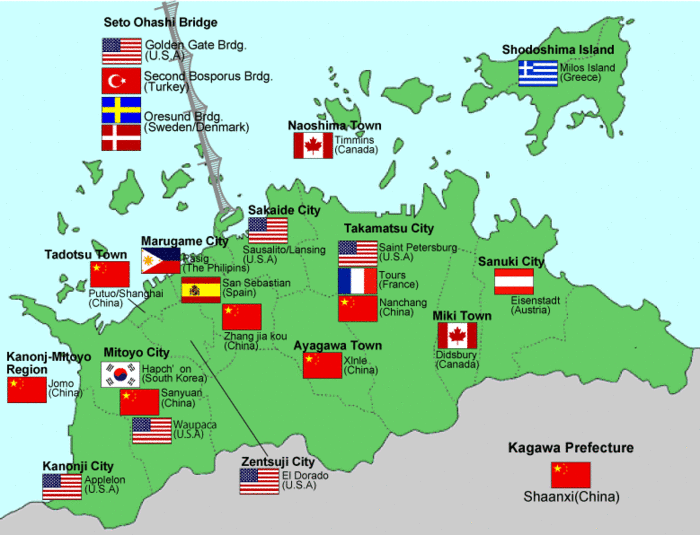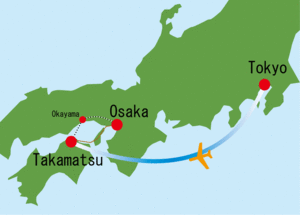2008アーカイブ

Ritsurin Garden is a stroll-type landscape garden in the traditional style, located in central Takamatsu and recognized as a "national treasure" garden. Mt. Shiun provides the backdrop for the park's six ponds and 13 hills, complemented by cherry blossoms in the spring, verdant green in the summer, fall colors, and snow-dusted scenery in the winter.
>>>>>>>>>>Ritsurin Garden Official Website

Dedicated to the guardian god of the sea, the ancient Kotohiragu Shrine in Konpira is nationally renowned. Every year many pilgrims make the journey to Konpira, where reaching the main shrine requires a hike up 785 stone stairs, or 1368 to the farthest shrine.
Visitors to the shrine also enjoy the nearby kabuki theater “Kanamaru-za”, the oldest of its type in Japan. Konpira onsen is another popular spot.

This gorge cutting through the center of Shodoshima is a scenic site of natural beauty. The fall colors are especially popular, and visitors can look down on them from the ropeway that runs to the top of the mountain.

The dual-purpose road and rail Seto Ohashi Bridge spans 9.4 kilometers. Its six bridges leapfrog between five islands across the Seto Inland Sea. Seen from the Seto Ohashi Memorial Park on the Shikoku side, the bridge stretches majestically across the ocean-blue strait.

Marugame Castle was built at the end of the 16th century by the warlord Ikoma Chikamasa. It is famous for its dynamic stone walls, which are sometimes described as a fan-shaped slope. The castle is a designated place of national historic interest.

Yashima - the “roof island” - is a roof-shaped lava plateau rising out of the Seto Inland Sea as a peninsula. The view from the observatory on top is spectacular, presenting a panoramic view of the Seto Inland Sea and its many islands.

Kotohiki Park’s white sand and green pines are well-known scenic spots in Ariakehama. Inside the park is a large sand sculpture of a coin known as “zenigata”, with a circumference of 345 meters.

Kinrin Park is known as “Tsuda-no-matsubara”. It includes thousands of pine trees more than 600 years old, and lovely views of the sharp contrast between white sand and azure sea. The beach is very popular with sunbathers and swimmers in the summer.

Referred to as the “inner parlor of Sanuki”, Shionoe is one of the region’s most popular hotsprings - or "onsen" - destinations. With its proximity to Takamatsu city and the airport, and a number of valleys and other scenic spots, Shionoe is a great place to enjoy being nestled in the mountains.
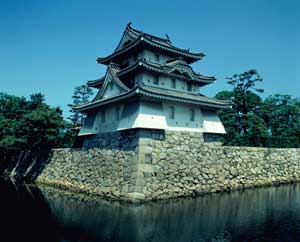
Tamamo Park is a small park built on the former site of Takamatsu Castle. The castle itself faces the Seto Inland Sea on the north, and is bounded on the three remaining sides by a moat filled with seawater, a rarity in Japan.
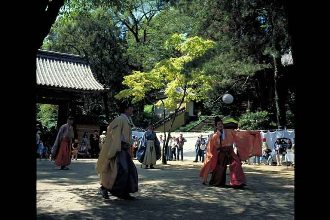
From its introduction from China (along with Buddhism) 1400 years ago, the sport of kemari has a long history in Japan. Originally a game played by the Emperor and other nobility, the Shogun, warrior classes, and monks and priests of Buddhist and Shinto affiliation, the sport spread in popularity and was eventually enjoyed by people of all classes, ages, and genders.
“Dedication kemari” takes place on May 5th at Kotohira Shrine. Participants don colorful costumes and, after praying at the shrine, offer the ball to the gods before playing with it. They then demonstrate the fantastic techniques employed when playing kemari.
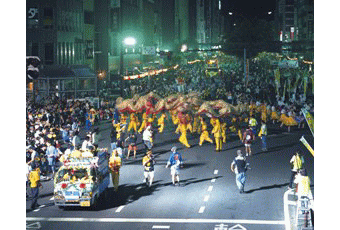
The Taki-no-miya Nenbutsu Dance originated 1000 years ago. The year 888 saw a long drought in the Sanuki region. The provincial governor prayed for rain and, when it actually began to fall, his overjoyed subjects began to dance. Their ecstatic movements are said to be the origin of today’s dance.
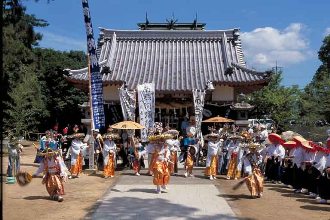
The Taki-no-miya Nenbutsu Dance originated 1000 years ago. The year 888 saw a long drought in the Sanuki region. The provincial governor prayed for rain and, when it actually began to fall, his overjoyed subjects began to dance. Their ecstatic movements are said to be the origin of today’s dance.

The chousa is a large drumming platform used in festivals. Toyohama in Kanonji holds the Chousa Festival in fall. Twenty-some of these floats are decorated with gold thread and other adornments and paraded around town for three days.
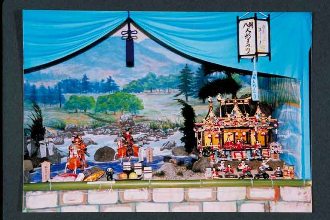
Nio, in Mitoyo, has a festival every year on September 20th to pray for the healthy growth of their children. Stages are constructed from rocks, sand, and vegetation in front of stores or in tatami rooms; people use these stages to recreate famous scenes from well-known historical events.

The old "kaido" highway in Busshozan, Takamatsu, is a good example of a traditional village built up around a temple. Old shops and homes are preserved even today.
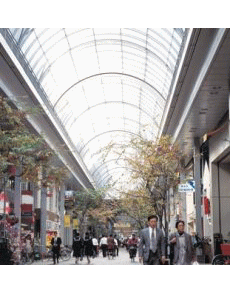
Characteristic of castle towns, Takamatsu is laid out in a grid-like pattern, with many one-way streets. The shouten-gai, or shopping arcade, might be called the nucleus of the city, with eight arcades and a combined length of 2.7 kilometers (which also makes it the longest shopping arcade in Japan). Approximately 800 shops, bars, and restaurants stand side by side in and around the arcade.
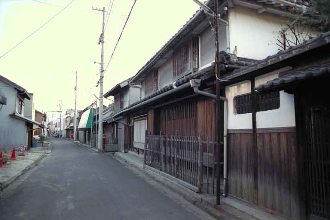
Facing the ocean in eastern Kagawa, Hiketa has been an important point of trade for soy sauce and the Three Sanuki Whites (sugar, salt, and cotton) since the Edo Period. The many ships transporting goods from Hiketa made it one of the most important port towns in eastern Sanuki. Some of the feeling of a castle town remains even today, and you might feel like you’ve been transported back in time as you walk its streets.
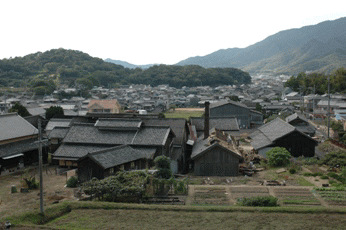
A walk along the main street in Uchinomicho, Shodoshima, gives visitors a glimpse into a past era; old soy sauce warehouses and breweries line the way. Soy sauce, one of the island’s traditional products, is a piece of living history.
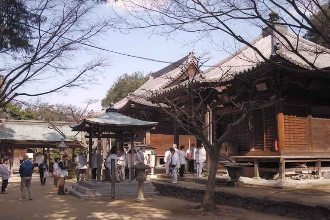
The Shikoku 88-temple pilgrimage follows the footsteps of Buddhist priest Kuukai (Kobo Daishi), who was born 1200 years ago in present-day Kagawa Prefecture. Pilgrims (henro) follow the path in distinctive white garb and bamboo hats. Recently young people, looking for peace of mind more than spiritual healing, have set out on the route. Kagawa Prefecture is home to 22 of the temples on the route, from number 67, Daikouji, to number 88, Ookuboji.
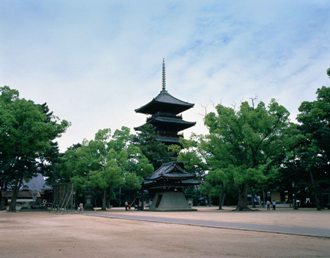
Zentsuuji is most famous for being the birthplace of Kobo Daishi (Kuukai), and is also the organizational headquarters for Shingon Buddhism. The grounds of the temple contain a 45 meter tall five-story pagoda, and many historical buildings ranked as national treasures.
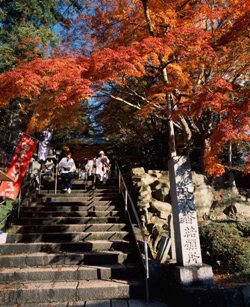
Located in Sanuki City this temple is number 88, the last on Shikoku’s pilgrim route. Though nearby parking lots have recently enabled access by car, the route used to be a very difficult one through 18km of foothills. Pilgrims arriving here reflect on their long journey, looking back on their memories and experiences. The temple grounds are lined with pilgrims' staffs (used as walking sticks on the route) and the crutches of those who have recovered from illness.
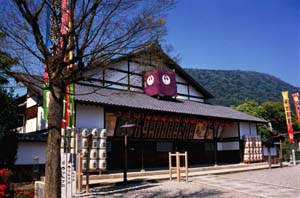
Standing on the side of the approach to Konpira Shrine, Kanamaru-za is the oldest remaining kabuki theater in Japan, having been erected in the Edo Era, and is designated a property of national cultural significance. Every spring a kabuki performance is put on by the most famous kabuki players, and is an extremely popular event.
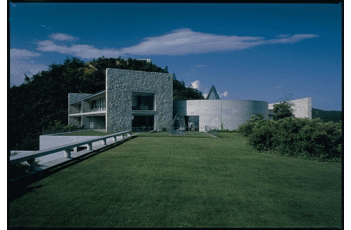
Locating in the northern region of the Seto Inland Sea, Naoshima is famous as an island of art. It includes a joint art museum and hotel, Bennesse House; a series of old houses which have been transformed into art works, the Art House Project; and the Chichu Art Museum, designed by Ando Tadao, in which works by Monet are displayed.
[Images]
1-Benesse House (Photo:Tadasu Yamamoto)
2-Benesse House Museum (Photo:Koji Murakami)
3-Benesse House Oval Guest Room
4-Art House Project "Kadoya" (Photo:Norihiro Ueno)
5-Art House Project "Kinza"(Being given:Rei Naito ,Photo:Noboru Morikawa)
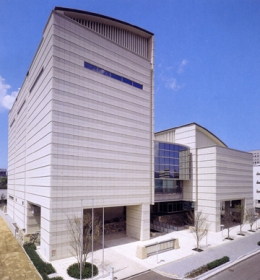
Renovated in April of 2008, this museum offers a combination of historical information and fine art. The collection includes approximately 1700 pieces, including a lavishly detailed map of Takamatsu from the early Edo Period, and a lively drawing of a shrine festival. The art collection focuses on local artists and contains Japanese- and Western-style paintings, as well as sculptures and industrial art pieces.
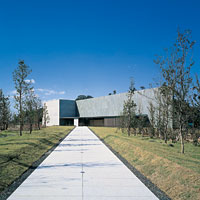
This gallery displays only the works of Higashiyama Kai-i, a Japanese-style painter who defined the Showa era. The building commands a view of the islands of the Seto Inland Sea where the artist’s grandfather was born. One can also see the light grey Seto Ohashi Bridge from the gallery.
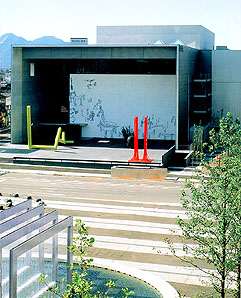
The Marugame Inokuma Museum Of Contemporary Art (MIMOCA) displays mainly the works of Kagawa-born Inokuma Gen’ichiro, supplemented by collections of various other modern art pieces from inside and outside Japan. The building itself was designed by Taniguchi Yoshio, the architect who designed New York’s MOMA.

The workshop that world famous sculptor Isamu Noguchi during the last few years of his life is now open to the public as an art garden. The 150 or so sculptures on display were chosen by Noguchi himself. His house - kept as it was when he was alive - has been arranged into a single exhibit along with a specially designed sculpture garden and a rebuilt storehouse display.
(Reservation required)

Located at the foot of historic Mt.Yashima, Shikoku-mura is a collection of ancient buildings from all over Shikoku. Framed by the greenery of the surrounding forest, nostalgic structures such as old houses brought from all four corners of Shikoku are on display, along with a vine bridge, a traditional teahouse, storehouses and a farmers’ kabuki stage.
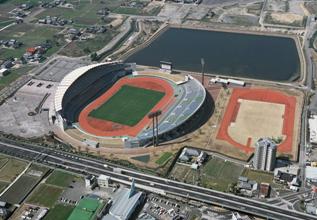
Marugame Stadium can accommodate national and international competitions in sports such as soccer and rugby, as well as track and field meets. Along with being the venue of the yearly Marugame Half-Marathon, a national event, it is used by international athletes for training camps prior to the Athletics World Championships and the Olympics.
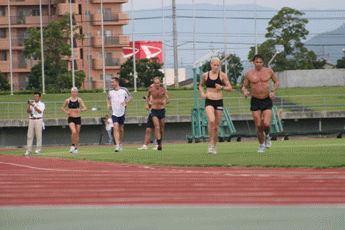
Kagawa prefecture is ideally suited as a venue for athletic training camps due to its warm climate and peaceful environment. Prior to the 2007 World Athletics Championships in Osaka, the four countries of Scandinavia elected to hold their training camp here. In preparation for the Beijing Olympics 2008, the Finnish athletics and rowing teams are scheduled to hold training camps here again.
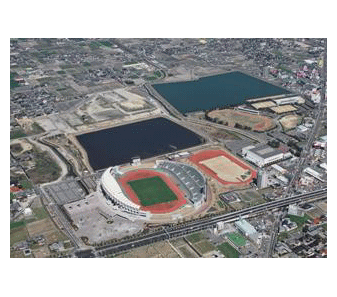
This half marathon is held on the first Sunday in February every year. The official course was laid out in 2000. In 2001, Naoko Takahashi, gold medalist in the Sydney Olympics, took part in the run, and in 2005 Mizuki Noguchi, gold medalist in the Athens Olympics, took part, bringing great prestige to the event.
On the day before the race, famous runners hold jogging classes, and souvenir and local Sanuki udon noodle stands are set up for the runners when they finish the race.
In 2009 the race was recognized by the International Association of Athletics Federations (IAAF) as an international competition, and is drawing many foreign athletes.
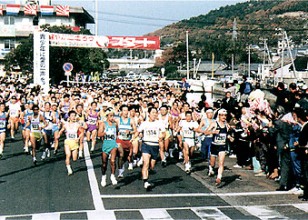
Rather than competing for time, the greatest achievement is to reach the goal and complete the marathon. The run is held on Shodoshima in the Seto Inland Sea every autumn.
Free bowls of nyu-men noodles are on offer, and there is free use of hot baths for participants. A t-shirt and towel are awarded to all those who complete the race.
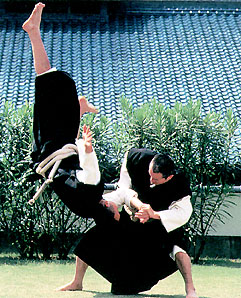
Shorinji Kenpo was founded in Tadotsu Town in Kagawa in 1947 by Doshin So, earning him the title kaiso (founder). It was formed as a way to develop one's personality through a combination of learning, mastery of techniques, and influence from a unique educational system. The headquarters of Shorinji Kenpo is currently located in Tadotsu Town.

There are five professional sports clubs in Kagawa. They are all beloved by the local people because they each work closely with the community, guiding yours athletes and organizing events.
Joining the Japanese players on each team are various young people from around the world. Each team strives to become champions of their league or gain promotion to higher leagues through constant practice sessions and matches.
Previously, people could only enjoy sports in Kagawa by playing themselves or watching nationally broadcast pro-baseball games on TV. However with the advent of home teams for Kagawa, people have begun to pack the stadiums, cheering on their hometown favorites and a new way to enjoy sports has come to Kagawa.
[ Club name (Sport, League Name) ]
Kamatamare Sanuki(Soccer, Shikoku Soccer League)
Kagawa Olive Guyners(Baseball, Shikoku/Kyushu Island League)
Takamatsu Five Arrows(Basketball, BJ League)
Shikoku Eighty 8 Queen(Volleyball, Challenge League)
Surpass Kagawa Ice Hockey Club (Ice Hockey, Western Japan Ice Hockey League)
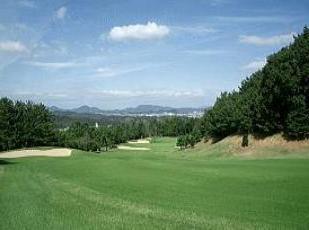
Because winters in Kagawa Prefecture are on the warm side and seldom see any snow, golfers may play year-round. There are many golf courses within a few minutes’ (and many more within a few hours’) drive of the airport, so it’s easy to tee-off the day you fly in.
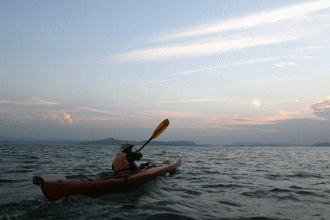
Courses that paddle through the Seto Inland Sea, meandering among uninhabited islands and beaches free of people, are a popular attraction. The beautiful scenery and relaxation of a personal ocean cruise is certainly worth a try. Tour companies offer half-day courses for the beginner, and two-day, one-night kayak camping trips for the paddler.
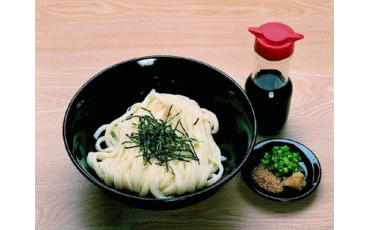
Udon noodles from Kagawa are so famous that one always thinks of Sanuki (the ancient name of Kagawa) when they hear the word “udon.” Made from superior quality wheat and salt, the quantity of which varies depending on the season, this thick and tasty noodle is a must for every visitor. Somen noodles are another well-known kind of noodle produced in Kagawa. Also made from a superior quality wheat, this noodle is kneaded by hand and then stretched out into extremely thin threads and dried in the sun.
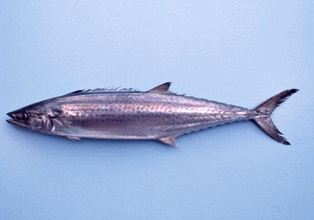
In spring, there is japanese spanish mackerel (sawara), in summer, butterfish (managatsuo), in autumn, black sea bream (chinu, kurodai) and in winter, young yellow tail (hamachi, buri). A great variety of seasonal seafood is caught throughout the year.

Grilled chicken on the bone, whole legs of chicken fried in spices, is a popular dish in Kagawa. In Marugame, Kagawa, the oldest honetsuki-dori shop opened in 1952, and has opened several branch restaurants since then. Along with these restaurants, many bars (izakaya) and grilled chicken restaurants (yakitori) offer this as an item on their menus. In total over 80 restaurants in Kagawa serve honetsuki-dori. Each restaurant uses different seasonings and grills its chicken differently, so it's fun to try various restaurants' styles.
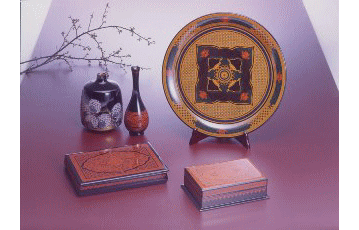
Many traditional arts and crafts came to Kagawa prefecture due to its position as an important gateway for maritime trade. Made with natural materials using traditional methods, these are still well loved parts of peoples’ lifestyles to this day.
In Kagawa, there is a system to recognise traditional craft products which require particularly great skill, or which have a long history. These are called “Kagawan Traditional Crafts”. By February 2006, 37 different product were recognized by the program.
Among these, Kagawa lacquerware and Marugame hand fans are also recognized as National Traditional Crafts.
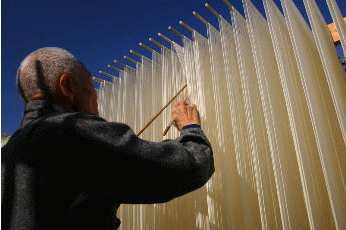
Somen: wheat and cold water are kneaded together, then stretched out into fine, thin noodles and dried in the sun. These are the oldest form of noodles found in Japan, and it is said they have their roots in China. The noodles produced on Shodoshima island, one of the top three somen producing regions in Japan, are well known for their firm texture and distinctive flavor.
Soy Sauce: produced by fermenting boiled soybeans and wheat, soy sauce has been made in Kagawa for over 400 years. Kagawa soy sauce is famous nationally, and traditional production methods are passed down from generation to generation. Soy sauce is an indispensable condiment when eating Sanuki udon noodles.
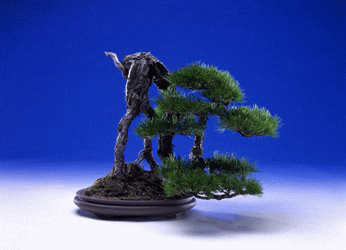
Bonsai: first created in the Edo Period 200 years ago, Kagawa's pine bonsai hold an 80% market share in Japan. Training miniature trees into beautiful shapes for the enjoyment of the observer takes great artistry. Bonsai is popular around the world, and Kagawa's bonsai is exported to the EU, the United States, Korea, Taiwan and many other countries.
Olive products: the climate of the Seto Inland Sea is warm and moderate like the Mediterranean. In 1908, olive saplings were imported from the United States and planted in three places in Japan. Of those three, the only place where the olive trees took root was Shodoshima, in the Inland Sea, and so this became the first place to produce olives in Japan. Green olives harvested in autumn are preserved in salt and eaten. Black olives, harvested in winter, are made into olive oil, which can be used in cooking, makeup and for medicines.
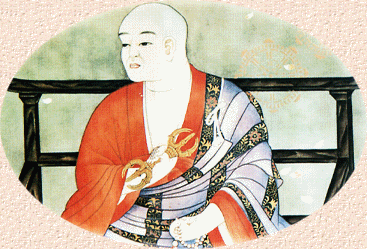
Kuukai, also called Kobo Daishi, was born in Sanuki (now Kagawa) 1200 years ago. He became a priest and went to Tang, China, to study Buddhism. Upon his return, he brought back not only Buddhism but also various other gifts, art and culture. He contributed greatly to the progress of Japan and was one of Japan's greatest pioneers of international exchange.
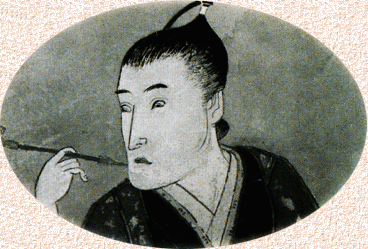
Hiraga Gennai was a clansman of the Sanuki Takamatsu han (feudal domain) in the Edo period about 200 years ago. He was a pharmacologist. Later in life, he went to Edo and Nagasaki and was exposed to books and other ideas imported from the West. He was active in various fields: he invented a hand-operated electric generator and a thermometer and also wrote plays. He was a Renaissance man of a kind rarely seen in his day.
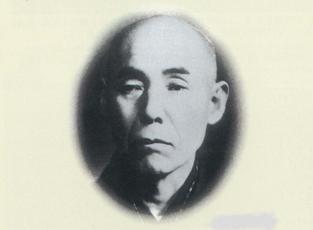
Ninomiya Chuhachi invented a propeller-driven plane in 1894 when he was serving in the Marugame regiment in Kagawa; this was well before the Wright brothers' invention in 1903. Due to a lack of funds, however, his invention could not be put into practice.
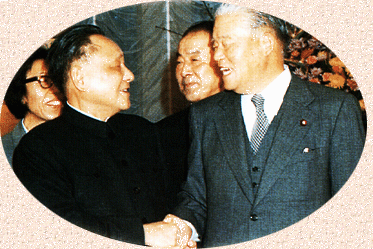
Ohira Masayoshi was born in Toyohama, Kagawa. In 1978 he became prime minister of Japan, where he contributed to the normalization of diplomatic relations and the conclusion of a peace and friendship treaty with China. He died while in office, in 1980.

Kagawa has long hours of sunshine and a warm climate, and so can produce a wide variety of crops. Although there is only about 7,000㎡ of arable land per farm family, by combining the main product, rice, with wheat, vegetable fruit, horticultural products and livestock, Kagawa actually has a high productivity rate, and its produce is of high quality.
Kagawa is the number 1 producer of red carrots, olives and marguerite in Japan.
Kagawa prefecture's farmers have created several patented strains of various crops, which are used for production of high quality foods and drinks. Sanuki Yoimai rice is highly prized as a strain which produces a very balanced, clear tasting sake (nihonsyu).Wheat for the nationally renowned Sanuki udon noodles, known as Sanuki no Yume 2000 is another exclusive crop, as are Sanuki Hime strawberries and Sanuki Gold kiwi fruits.
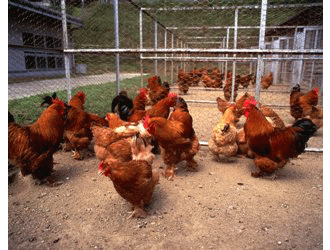
Though the total number of cattle and poultry is low, this industry has a long tradition of intensive management. It is an important sector financially, grossing 25.6 billion yen in 2006, which represents 32.2% of the 79.6 billion yen that Kagawa's agriculture industry grossed overall.
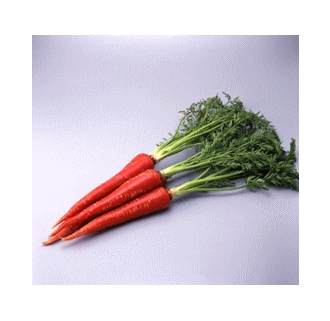
"K. Brand" is a system in Kagawa to recognize products of a particularly high quality. There are three criteria by which a product may attain "K. Brand" status:
1. The product is of particularly high quality
2. The product is recognized as having something unique about it or its production method
3. The product has something special about it's ingredients or preparation
"K. Brand" is administered by the Council to Promote Distribution and Consumption of Kagawa Products. It is a symbol of Kagawa’s confidence and pride in these products.
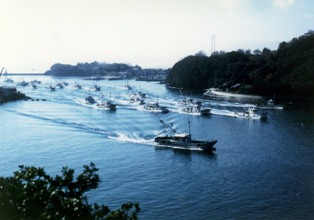
Cultivation of laver (nori) and Japanese amberjack (buri) are highlights of the Seto Inland Sea fisheries industry. Seasonal production focuses on the lancefish (ikanago) and anchovy (katakuchi-iwashi); many varieties of fresh fish are available year round.
Large-scale cultivation of Japanese amberjack (13,000 tons in 2002, fourth in the nation), and laver (38,000 tons in 2002, fifth in the nation) make Kagawa an important national producer of these two products. Other important varieties include red Pacific sea bream (madai), flounder (hirame), oysters (kaki), red clam (aka-gai), wakame, and konbu seaweed.
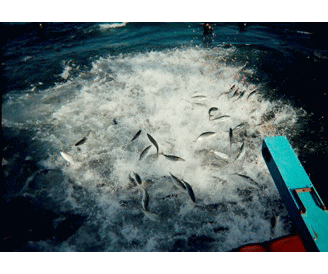
The yellowtail is called by different names as it ages. In Kagawa, this progression is tsubasu, hamachi, mejiro, and then buri.
In 1920, Wasaburo Noami successfully cultivated the first Japanese yellowtail in Adoike, a salt water pond in present-day Higashi Kagawa (then known as Hiketa). Hamachi went on to be named Prefectural Fish in 1995. Recent years have seen it become a very important part of Kagawa’s fisheries industry, where it is raised from April to December or January.
Favored ways of preparing hamachi include serving it as sashimi: sliced raw, and served on its own fat. Cooking it teriyaki style or salted and broiled are both appropriate, and lately shabu-shabu preparation is in vogue.
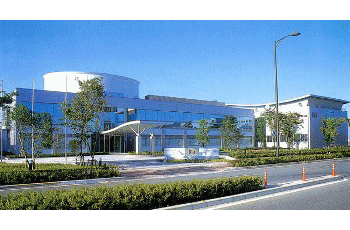
Many public facilities such as FROM Kagawa (Kagawa Prefecture Science and Technology Center), NEXT Kagawa (Support Facility for New Industry), The Research Institute for Solvothermal Technology, The Kagawa Industrial Intelligence Center, The Kagawa University Department of Engineering and The National Institute of Advanced Industrial Science and Technology, Shikoku are based here in Kagawa, and many private facilities researching and developing the latest technology have located to the surrounding areas, which has led to a new city developing out of this cluster of R&D facilities and industrial support facilities.
The idea behind the Kagawa Intelligent Park is to use this agglomeration of industrial, academic and government facilities to its full potential and offer support to research and development projects in emerging fields such as nanotechnology and biotech sugar research. We aim to establish the park as "a centre for creating new industries and new research and development by linking industry, academia and government."

The Takamatsu Container Terminal was opened in March of 1997, in Takamatsu Port's F-area (Takamatsu, Asahi Shinmachi). Expanding trade is focused on Asian countries such as China and Korea, and charter container ships transit from Pusan, Shanghai, and Tsingtao. Plans are in the works to increase trade capacity by expanding the yard and adding additional facilities to the terminal. The opening of the trans-Shikoku expressway has made the port even more convenient.
Current plans are also being developed for the installation of a 30,000 ton, 12-meter submerged breakwater in the F-area. It is also necessary to develop this international terminal to meet the demands of increasingly large freighters carrying an increasing amount of cargo. Further functional enhancement is aimed at earthquake resistance, and in ensuring an easy rebuild in case of damage from an extremely large-scale earthquake. With these improvements, we hope that the terminal can also prove an agent of vitalization for local economic development.

Kagawa Prefecture is blessed with a rich natural environment, from the myriad beautiful islands of the Seto Inland Sea, to the green of the mountains in the Sanuki Range, to the ponds and groves dotting the Sanuki Plain. It is our responsibility to pass on that which has been handed down to us in this, our irreplaceable home.
The prefecture strives to maintain the environment through a variety of policies, including measures targeting pollution and illegal dumping. Climate change prevention initiatives take place at the local level, too, with the promotion of energy saving both at home and in the office, and suggestions for savings in daily life. The prefecture is also examining the possibility of assigning responsibility for climate change policies to individual workers.
We believe that it is important to build a recycling-oriented society, and to promote a local culture in which every citizen recycles at home and at work in order to tread more lightly on the earth.
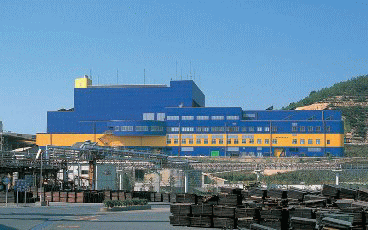
The town of Naoshima is blessed with a beautiful natural environment, part of the 27 islands of the Seto Inland Sea. The “Eco-Island Naoshima Plan” describes the creation of a recycling-oriented society that could be used as a model on a national level. The Japanese government (Ministry of Economy, Trade, and Industry; Ministry of the Environment) approved the plan as progressive and unique, a first among island municipalities.
The plan outlines a new environmental industry (infrastructure support), and towns built up in harmony with the environment (social support).
The infrastructure support calls for reclamation of materials from disposal facilities: the waste streams from fly ash, disposed household electronics, and dust from automobile shredders, will become a “town mine”, and will be processed to reclaim gold, silver, copper, lead, zinc and other valuable metals instead of burying them. Waste heat will also be reclaimed and used to produce power.
The social support entails the cooperation of local residents and workers with the government to decrease waste, plant trees and flowers, and hold workshops and symposiums on the environment.

Kagawa Prefecture contains approximately 880km2 of forest, which makes up about 47% of the total area of the prefecture. Most of these forests are comprised of deciduous broad-leaved trees (such as the sawtooth oak, or kunugi, and konara oak, or konara) and pines. Around 85% of the forests are close to human populations, and have long been utilized by them. These forests must be maintained not just by the landowners and logging companies, but by everyone in the prefecture.
Since 1992, the Donguri (acorn) Bank has promoted opportunities for prefectural residents, particularly children, to experience the forests all around them. The planting of saplings, trimming of underbrush, and other activities, reinforce the importance of forests, and allow locals to become better acquainted with their preservation. The bank uses acorns as the unit of currency, representing them not with \ but with a D (for donguri, or acorn). Deposits can be made, and when an account reaches a certain level, the deposit is exchanged for a sapling which can then be planted. The bank is very popular among children; there were 16,000 account holders registered as of 2005.
Increased activity in forests leads to increased awareness, and volunteer activity in forest maintenance is on the rise.
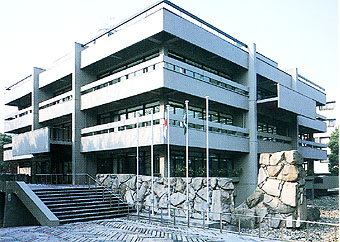
Formally known as the “Kagawa International Exchange Association”, IPAL is a center of multicultural exchange. Asking for “friendly” names upon opening the facility is now known as “IPAL Kagawa”. The “I” is for love (ai), the “i” in international exchange and information, and the personal pronoun I. "Pal" means friend.
IPAL acts as a center for international exchange, gathering friends and distributing information from many different places. The facility was created with these goals in mind, and to be a place easy to come to and interact at.
The Exchange Floor in IPAL is open for use, as are the International Cooperation Plaza, Library, and exhibition hall.

With more than 2000 hours of sunlight per year, Kagawa is representative of a warm Seto Inland Sea climate. Around 1000mm annual rainfall makes it one of the driest regions in Japan.

Prefectural Flowew and Tree: Olive
Prefectural Bird: Cuckoo
Prefectural Animal: Deer
Prefectural Fish: Yellowtail

Kagawa Prefecture is in the center of the Seto Inland Sea region, and has been a key junction of transportation for a long time. With the completion of the Seto Ohashi Bridge and Takamatsu Airport, and improvements to the expressways crossing Shikoku, Kagawa’s importance as the portal to Shikoku can only grow.

The Seto Ohashi Bridge stretches 9.4 kilometers from Sakaide in Kagawa to Kojima in Okayama. It is made up of several different types of bridges, including suspension, truss, and cable-stayed. Its two separate levels serve as an expressway for cars (upper level), and tracks for a railway (lower level), making it possible to reach Okayama in less than 10 minutes. In addition to being a valuable amenity for both regional industry and local citizens, the bridge is an important asset to tourism.

Appropriate to the “sky portal of Shikoku”, Takamatsu Airport was built with scale and function in mind. A total area of 154 hectares includes a 2500 meter runway which can accommodate large passenger jet planes, as well as technologically advanced “intelligent buildings” including the terminal, cargo facilities, and parking lot. Since it opened in 1989 Takamatsu Airport has seen a steady increase in the number of scheduled and charter flights domestically and worldwide.
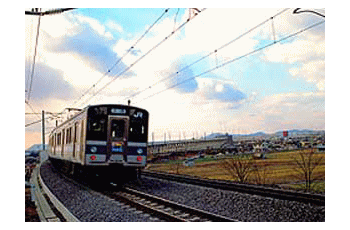
Kagawa Prefecture is linked with other major cities on Shikoku by Japan Railways (JR) lines. The dual-purpose Seto Ohashi bridge joins Kagawa to the mainland via road and rail and makes this prefecture the center of Shikoku’s transportation infrastructure. The local Kotohira Dentetsu (or Kotoden) line facilitates travel between Takamatsu City and its suburbs and is used extensively by daily commuters.

The Trans-Shikoku Expressway forms a figure-eight on Shikoku, crossing Kagawa Prefecture. Direct links between major cities (Takamatsu, Tokushima, Matsuyama, and Kochi) provide for a travel time of around two hours to any of them. Thanks to a connection with the Seto-Chuo Expressway (which traverses the Seto Ohashi Bridge to the mainland) and plans for even more links, Kagawa Prefecture is playing an ever greater role in the transportation of goods and people.

Kagawa’s principal ports include Takamatsu, Sakaide, Marugame, and Takuma. There are regular and high-speed ferries between Shikoku and Honshu, and there are always cargo ships, tankers and others going to and fro.

Takamatsu Port has long functioned as the sea gateway to Shikoku, and is now one of the country’s most-used ports. It also ranks high for number of ships docking and cargo carried.
The Takamatsu Port container terminal was finished in 1997, and opened the doors to international container ships from Pusan in Korea. The 11000m2 site includes free-moving cranes.
Implementation of a 2-ton berth and associated terminal buildings was completed in 1999, allowing for large passenger ships to dock in Takamatsu.

The newly redeveloped JR station building at Takamatsu Port, dubbed “Sunport Takamatsu”, is intended to be a central point of transit by land and sea, and to meet the needs of this age of internationalization and computerization. The facility realizes the beauty of the Seto Inland Sea while providing for the further development and progress of Takamatsu.

Kagawa Prefecture is located in the north-eastern part of Shikoku, an island in the southwest of Japan. Playing a central role on the island, Kagawa is bordered on the south by the verdant Sanuki Mountain Range and to the north by the scenic Seto Inland Sea.

Kagawa Prefecture forms a half-moon; the Sanuki Mountains to the south reach heights of 800 meters and gradually descend north into the fertile Sanuki Plain. North of this is the Seto Inland Sea, home to more than 110 islands of various sizes.
With an area of 1876km2, Kagawa Prefecture is the smallest in Japan.

Kagawa is the 40th most populous prefecture in Japan, and its one-million people account for approximately 0.8% of the national population. It ranks 11th nationwide in terms of population density, however, with 540 people per square kilometer.

Kagawa is organized into 8 shi (cities) and 9 cho (towns). The largest city, Takamatsu, is home to the prefectural office and 420,000 people, 40% of the prefectural population.
 Kagawa Prefecture, Japan
Kagawa Prefecture, Japan





